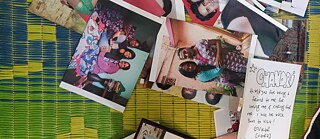Interview with Chandri Narayan and Sadhna Prasad
Friendship is a form of social justice activism

How did you find out about your story’s protagonist and movement?
Chandri and Sadhna are part of an Aravani Art Project collective. Our art collective is led by women and trans women based in India. While the visibility of transgender people is increasing in popular culture and daily life, they still face severe discrimination, stigma, and systemic inequality. With a mission of attempting to reduce this in society, we at Aravani Art Project bring about change in the way society views the transgender and queer community through the various forms of art. Chandri and Sadhna met as friends, colleagues and mentors to each other in this project.
What gives you the most pleasure while working on the project?
We have had a beautiful research phase and have enjoyed every step of it. We began by exploring Chandri’s emotional and life mapping and then turning that into key elements, stories and imagery. It has been extremely satisfying visiting Chandri’s hometown, interviewing her friends, neighbors and acquaintances from all areas of her life, the usual places where she lives, and exploring her growth through her own eyes.
How are you trying to give back to the community?
This project in its entirety is as much by and for the community as it is for the general public. Chandri, the protagonist, is the storyteller of her own story, where Sadhna has helped her form a narrative, chosen the story she wants to tell and shaped it. The process from storyboarding to finishing involves Chandri evolving in every stage and has all the inputs from our research space. It tells the story of a unique individual, an artist, Chandri, who is also a trans woman, and emphasizes that the transgender community is formed of many such unique individuals and their respective journeys.
What should ideally happen after the project’s publication?
We wish for this book to be a breath of fresh air for people to get used to nuanced, colorful individual stories of different people from the trans community. In this project we have covered one aspect of Chandri’s life, one chapter. We hope it marks a new way of reading about someone’s life from the community: through an illustrated book, written and narrated by the concerned individuals and not by an external source. In the future, we hope to publish more such stories and also explore friendship as a form of social justice activism in their lives.